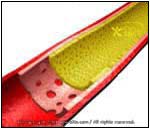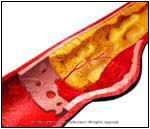
DESCRIPTION
* The aorta is the large artery that carries blood from the heart to the rest of the body. Anatomically, it arches over the heart, down the back of the chest cavity, into the abdomen. Though the wall of the aorta is thick, a tear may occur in the wall. Tears generally start from the inside and burrow downward. A tear in the aorta is called an aortic dissection. Aortic dissections are classified into two types, based on the location of the tear: If the tear is high in the aorta (ascending aorta and the arch) it is called Type A; lower (descending aorta), it is called Type B.
SYMPTOMS
* Sudden onset of severe chest pain
* Pain radiates down arms or into neck
* Sweating
* Loss of consciousness
* Shortness of breath
* Weakness
* Ripping/tearing pain in the back or chest

CAUSE
* A tear in the internal layer of the aorta that extends down the wall, creating a false lumen.
* Possibly, injuries during catheterization
HOW THE DIAGNOSIS IS MADE
* Examination:
1. Diminished pulses in wrists and/or legs/feet
2. Wide pulse pressure
3. Low or High Blood Pressure
4. Heart murmur
5. Lung crackles
* Electrocardiogram may show left ventricular hypertrophy. It may show myocardial ischemia (decreased blood to heart) if dissection extends into coronary blood vessels.
* Imaging:
1. Chest X-Rays show abnormal aortic contour or widened mediastinum (center cavity of chest) -- a widened area where the aorta is normally narrower
2. CT scan
3. MRI
4. Angiography (dye is injected into the aorta and X-Rays taken)
5. Transesophageal Echocardiography (ultrasound of heart done by passing a scope into the esophagus)

RISK FACTORS
* Long-standing High Blood Pressure
* Age
* Bicuspid aortic valve
* Aortic coarctation
* Pregnancy
* Marfan's Syndrome (a genetic disorder that results in a defect in components that make up wall structure of the aorta)
* Ehlers-Danlos syndrome
* Cardiac surgery
* Trauma to the chest
* Cocaine abuse
TREATMENT
* Medications:
1. Intravenous beta blockers decrease shear force and blood pressure
2. Intravenous nitroprusside to lower blood pressure
* Surgery:
Replacement of torn aorta with an artificial graft
* Note: Type A dissections nearly always need surgery, whereas Type B is generally managed with medications.
IF YOU SUSPECT THIS CONDITION
* You need emergency medical treatment. The death rate for untreated aortic dissection is 20% in the first day, and 90% over 3 months.
PREVENTION
* One of the major causes of aortic dissection is untreated High Blood Pressure. Proper monitoring and use of blood pressure medications will prevent aortic dissection in most cases.
SIMILAR CONDITIONS
* Myocardial Infarction
* Angina pectoris
* Aortic aneurysm
* Pulmonary Embolism
* Marfan's Syndrome



No comments:
Post a Comment